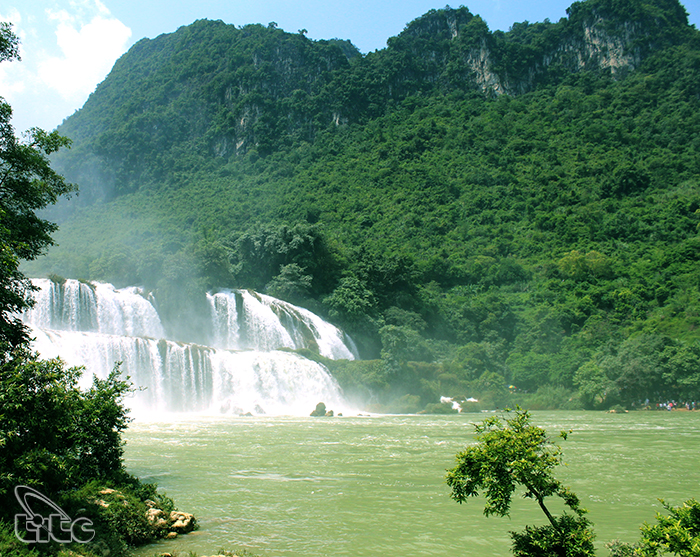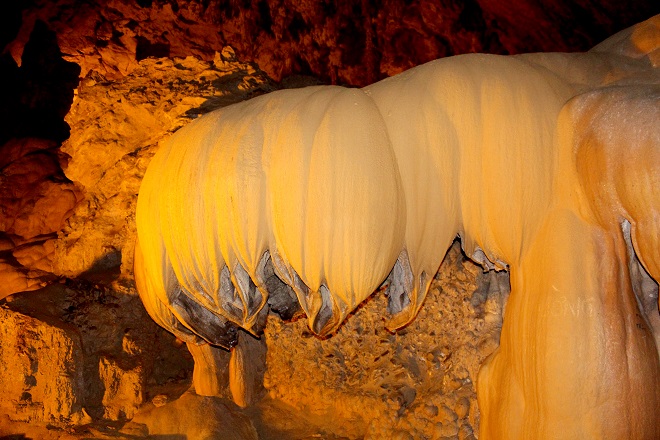(TITC) - Located in the North-East border region of Viet Nam with terrain of karst plateau alternated with mountains, Cao Bang Province has many spectacular and poetic natural landscapes, typically Ban Gioc Waterfall and Nguom Ngao Cave (Dam Thuy Commune, Trung Khanh District).

From Cao Bang City, crossing Ma Phuc Pass - Khau Lien Pass with the length of 89km, visitors will arrive in Ban Gioc Waterfall.
Originating from Quay Son River, Ban Gioc consists of two separate waterfalls. The main waterfall is to the north with a width of 100m, a height of 70m, including three layers. Seen from afar, it looks like a white silk trip crossing the hillside. This is the most beautiful and largest part of Ban Gioc Waterfall. The auxiliary waterfall in the south is less water than the main waterfall and usually dry in the dry season.
On sunny days, the steam from Ban Gioc Waterfall creates a sparkling rainbow. At the foot of the waterfall, the large river is calm as glass surrounded by many green grass and precious flowers.
To Ban Gioc, besides admiring the picturesque scenery, visitors can enjoy local specialties such as tram huong fish and Trung Khanh chestnut. A special feature of Trung Khanh chestnut is whether boiled, roasted, dried, simmered with pork leg or chicken, it remains the delicious and greasy taste. In addition, visitors can also visit Gioc Village (Ban Gioc) of Tay people with traditional stilt-houses to hear luon singing, then singing…
In Ban Gioc Waterfall Area, Phase 1 of 4-star Sai Gon – Ban Gioc Resort inaugurated in December 2014 includes 60 rooms, conference hall with a capacity of over 200 guests, restaurants serving Western, Asian cuisines and local specialities. Expectedly, Phase 2 of the project will consist of 80 rooms, sports centre, entertainment area, spa, camping and outdoor activity area...
The operation of Sai Gon – Ban Gioc Resort enriches tourism service and also connects tours in Cao Bang Province such as Pac Bo Relic Site, Lenin Stream, Thang Hen Lake, Nguom Ngao Cave...

Located about 3km to the south of Ban Gioc Waterfall, Nguom Ngao Cave was formed about 300 million years ago. According to Tay language, Nguom Ngao means the cave of tigers. Legend has it that, the sound of the stream inside the cave likes the growl of tigers, so the local people named the cave as Nguom Ngao.
Nguom Ngao Cave was discovered in 1921 by local people and then surveyed by British Caving Association in 1995. With the length of 2,144m, Nguom Ngao includes three main entrances namely Nguom Ngao, Nguom Lom and Ban Thuon. Going into the cave, visitors will be dazzled by wonderful seven-colored stalactites hanging down from high stone cliffs, of which some look like human bodies, forest plant, animals, lotus... Visitors can feel the harmony between stone and water.
Ban Gioc Waterfall and Nguom Ngao Cave are considered as must-see tourist sites for visitors when visiting Cao Bang Province.
Tourism Information Technology Center